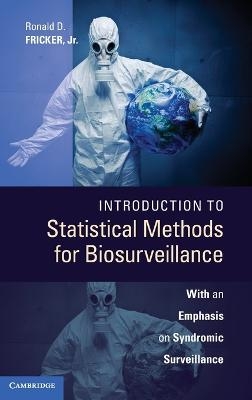
Introduction to Statistical Methods for Biosurveillance
Cambridge University Press (Verlag)
978-0-521-19134-0 (ISBN)
Bioterrorism is not a new threat, but in an increasingly interconnected world, the potential for catastrophic outcomes is greater today than ever. The medical and public health communities are establishing biosurveillance systems designed to proactively monitor populations for possible disease outbreaks as a first line of defense. The ideal biosurveillance system should identify trends not visible to individual physicians and clinicians in near-real time. Many of these systems use statistical algorithms to look for anomalies and to trigger epidemiologic investigation, quantification, localization and outbreak management. This book discusses the design and evaluation of statistical methods for effective biosurveillance for readers with minimal statistical training. Weaving public health and statistics together, it presents basic and more advanced methods, with a focus on empirically demonstrating added value. Although the emphasis is on epidemiologic and syndromic surveillance, the statistical methods can be applied to a broad class of public health surveillance problems.
Ronald D. Fricker, Jr is an Associate Professor of Operations Research and the Associate Chair for Research at the Naval Postgraduate School (NPS). Prior to joining NPS, Dr Fricker was a Senior Statistician at the RAND Corporation and the Associate Director of the National Security Research Division. Published widely in leading professional journals, he is a Fellow of the American Statistical Association, an Elected Member of the International Statistical Institute, and a former chair of the ASA Section on Statistics in Defense and National Security. He is a contributing editor to Interfaces and is on the editorial boards of Statistics, Politics, and Policy and the International Journal of Quality Engineering and Technology. Fricker's current research is focused on studying the performance of various statistical methods for use in biosurveillance, particularly syndromic surveillance, and statistical process control methodologies more generally.
Part I. Introduction to Biosurveillance: 1. Overview; 2. Biosurveillance data; Part II. Situational Awareness: 3. Situational awareness for biosurveillance; 4. Descriptive statistics for displaying the situation; 5. Statistical models for evaluating the situation; Part III. Early Event Detection: 6. Design and performance evaluation; 7. Univariate temporal methods; 8. Multivariate temporal methods; 9. Spatio-temporal methods; Part IV. Putting It All Together: 10. Simulating biosurveillance data; 11. Applying the temporal methods to real data; 12. Comparing methods to better understand and improve; 13. Frontiers, open questions, and future research.
| Zusatzinfo | 30 Tables, unspecified; 3 Maps; 143 Line drawings, unspecified |
|---|---|
| Verlagsort | Cambridge |
| Sprache | englisch |
| Maße | 162 x 242 mm |
| Gewicht | 670 g |
| Themenwelt | Mathematik / Informatik ► Mathematik ► Statistik |
| Studium ► Querschnittsbereiche ► Epidemiologie / Med. Biometrie | |
| Studium ► Querschnittsbereiche ► Prävention / Gesundheitsförderung | |
| ISBN-10 | 0-521-19134-3 / 0521191343 |
| ISBN-13 | 978-0-521-19134-0 / 9780521191340 |
| Zustand | Neuware |
| Haben Sie eine Frage zum Produkt? |
aus dem Bereich


